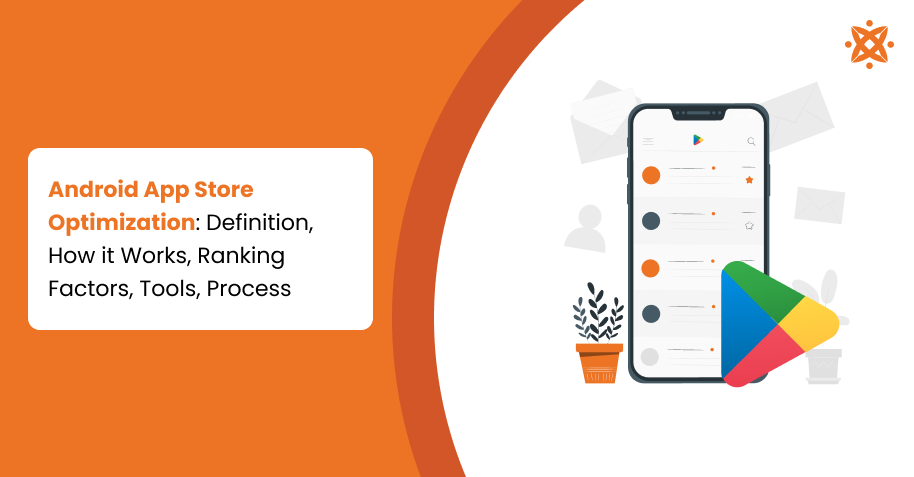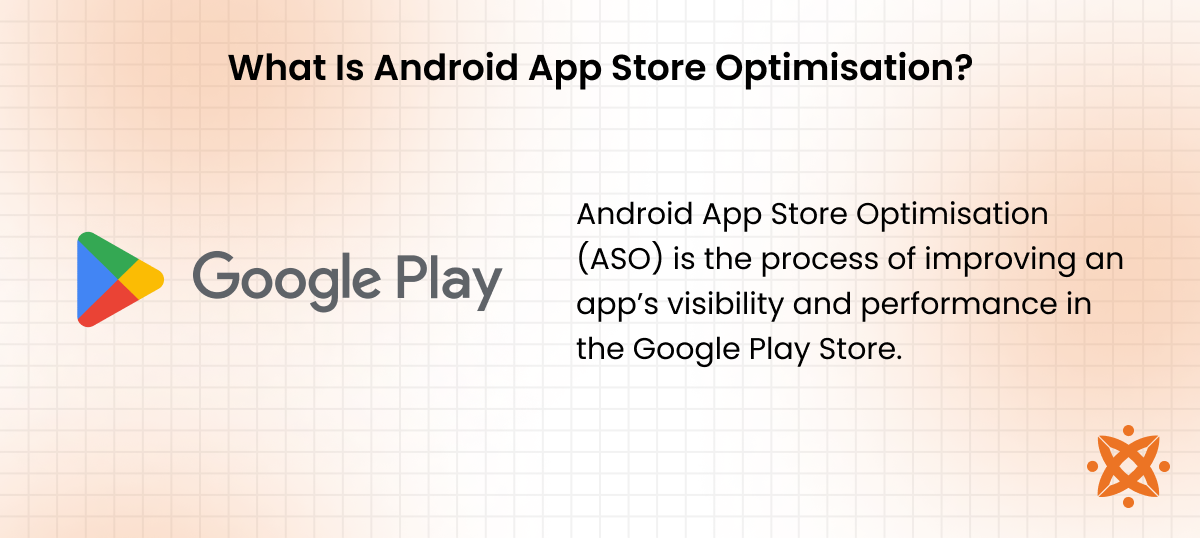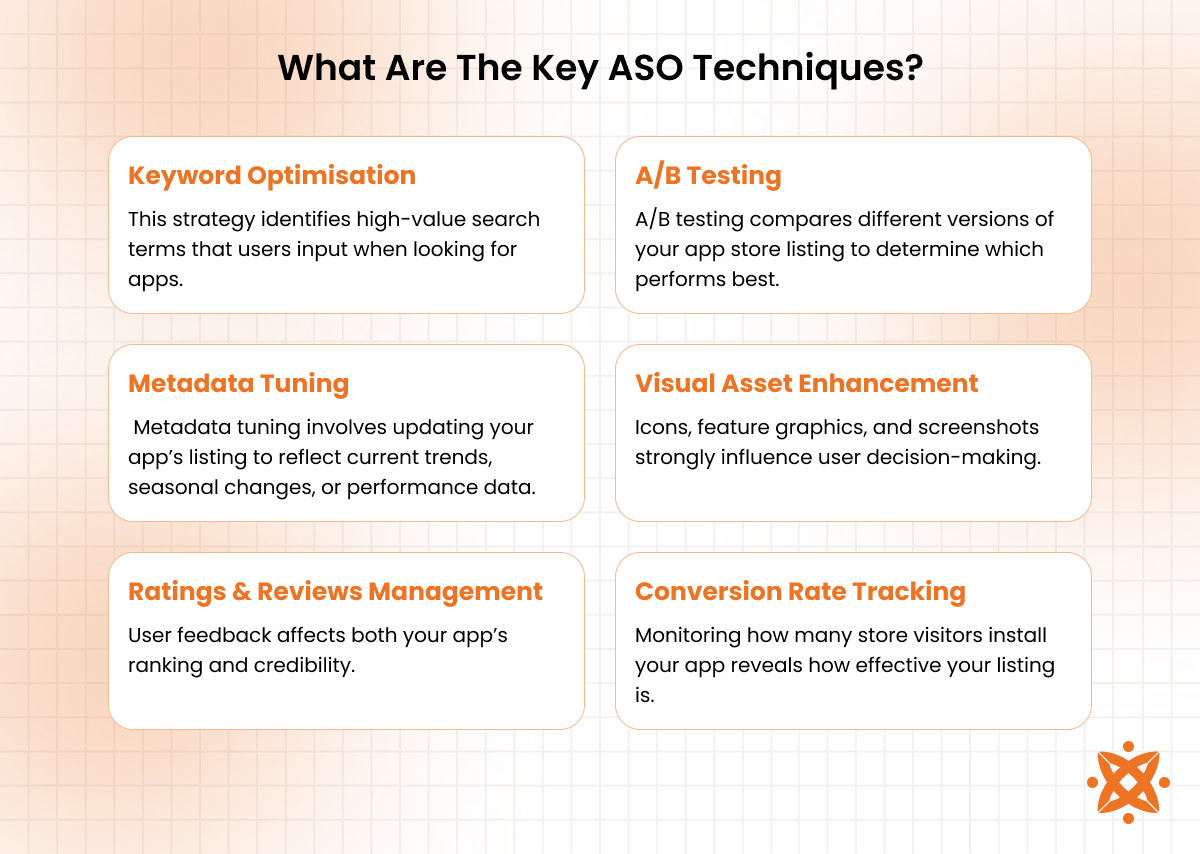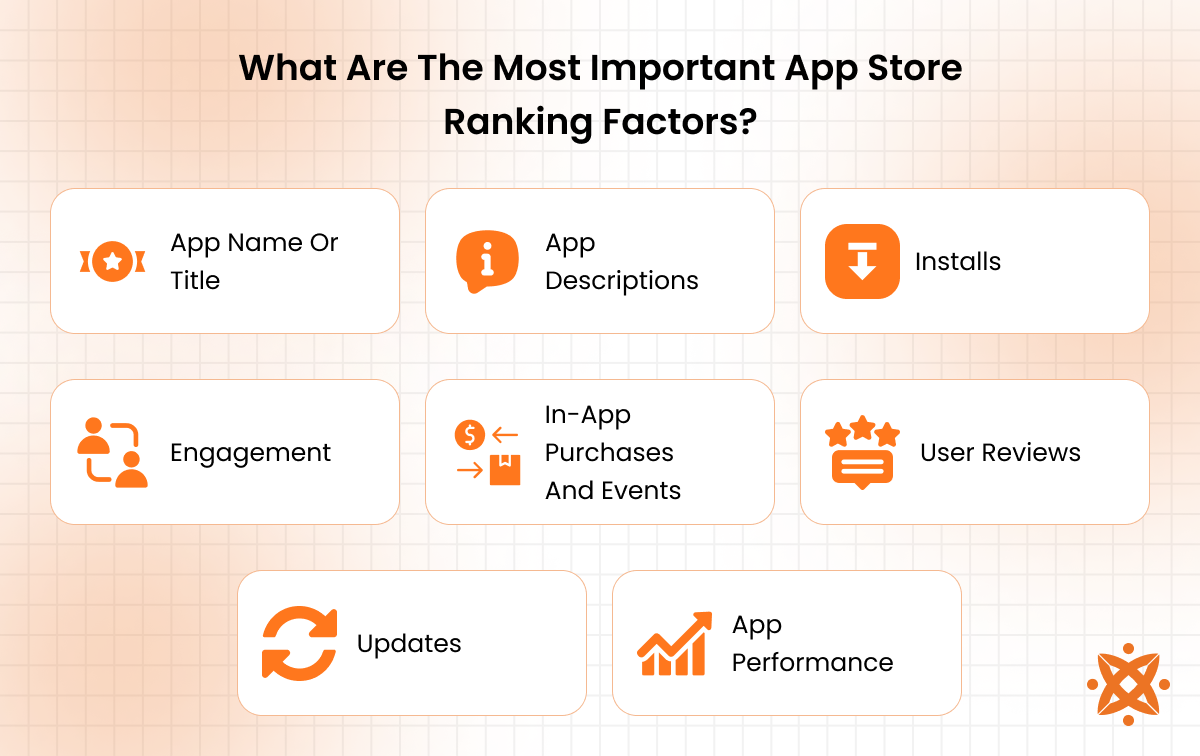
Android App Store Optimisation (ASO) improves how Android apps appear and perform within the Google Play Store to attract more users and increase app downloads. In real-world applications, ASO stands out in a crowded market, especially as mobile users heavily rely on search and visuals when selecting apps.
ASO works by aligning your listing's content with how the Google Play Store algorithm ranks apps. It uses fields like the app title, app description, keywords, and screenshots to determine search relevance. Combined with user engagement signals such as conversion rate, app ratings, and app reviews, ASO improves your visibility and supports long-term user acquisition.
The main app store ranking factors include metadata elements such as the app title and description, install volume, user engagement, review sentiment, and technical performance. These signals tell the store how useful and trustworthy your app is. Consistent activity, such as updates and positive ratings, helps maintain visibility over time.
The ASO process involves several steps: conducting keyword research, optimising metadata, improving visual assets, encouraging positive reviews, and testing listing elements. This structured approach ensures your mobile app marketing efforts deliver measurable improvements in search ranking and user engagement.
The main tools used in ASO include Google Play Console, Apptweak, Sensor Tower, and Mobile Action. These tools offer insights into keyword trends, competitor analysis, and listing experiments. These tools guide developers and marketers in making informed updates that align with market trends and user behaviour.
What Is Android App Store Optimisation?
Android App Store Optimisation (ASO) is the process of improving an app's visibility and performance in the Google Play Store. It involves strategic changes to the app's metadata, such as the title, description, icon, and screenshots, to increase discoverability and drive organic downloads.

ASO is important for Android apps because Google Play is saturated with millions of competitors. Without visibility, even the best apps struggle to gain traction. A properly optimised listing boosts ranking in search results and category charts, helping your app reach its target users more effectively.
The core goals of a strong ASO strategy include increasing organic app installs, improving conversion rates from store views to downloads, attracting high-quality users, and maintaining consistent app performance in search rankings.
How Does ASO Work?
ASO works by aligning an Android app's metadata with the search algorithms used by the Google Play Store. When users enter search queries, the Play Store analyses titles, short and long descriptions, keywords, reviews, and install metrics to determine which apps to display. Optimising these elements improves your app's chances of appearing higher in relevant search results.
The process involves keyword research to find what potential users are searching for, followed by refining the app's title and description to include these terms naturally. Visual elements like icons and screenshots also affect user behaviour and improve download conversion rates. Performance data such as ratings, reviews, and retention further influence ranking, making ongoing optimisation a continual priority.
What Are The Key ASO Techniques?
The key ASO techniques include keyword optimisation, A/B testing, metadata tuning, visual asset enhancement, ratings and reviews management, and conversion rate tracking. These techniques focus on enhancing visibility, increasing download conversions, and maintaining competitive positioning in the Google Play Store.

The key ASO techniques are:
- Keyword optimisation: This strategy identifies high-value search terms that users input when looking for apps. By incorporating these keywords into the title, short description, and long description, your app becomes more discoverable. It's important to use tools to track keyword performance and refine them regularly.
- A/B testing: A/B testing compares different versions of your app store listing to determine which performs best. You test icons, screenshots, descriptions, and other visual or textual elements. This data-driven approach helps maximise user conversion from store visits to downloads.
- Metadata tuning: Metadata tuning involves updating your app's listing to reflect current trends, seasonal changes, or performance data. This includes revising descriptions, promotional text, and graphics. Consistent updates help maintain relevance in the Play Store algorithm.
- Visual asset enhancement: Icons, feature graphics, and screenshots strongly influence user decision-making. High-quality visuals that communicate your app's purpose and benefits increase trust and download likelihood. They also make your listing stand out in competitive categories.
- Ratings and reviews management: User feedback affects both your app's ranking and credibility. Encouraging satisfied users to leave positive reviews, while addressing negative feedback promptly, improves your store's presence. Google also considers volume and freshness of ratings in its ranking.
- Conversion rate tracking: Monitoring how many store visitors install your app reveals how effective your listing is. Low conversion rates suggest that elements like descriptions or screenshots need improvement. This metric helps prioritise which parts of your listing to test or optimise next.
What Are The Most Important App Store Ranking Factors?
The most important Android app store ranking factors include app name or title, app descriptions, installs, engagement, in-app purchases and events, user reviews, updates, and app performance. These elements directly influence how your app is evaluated and ranked by the Google Play algorithm.

The most important Android app store ranking factors are explained below:
- App Name or Title: Your app's title signals its core function and includes valuable keywords. A clear, relevant name improves both visibility in search results and click-through rates. It sets the first impression for users browsing the Play Store.
- App Descriptions: The short and long descriptions convey your app's features and value. Optimised descriptions that incorporate strategic keywords help algorithms match your app to relevant searches. They also influence user decisions to download.
- Installs: The total number of downloads affects your app's authority in the store. Higher install counts suggest popularity and increase your app's credibility. This metric contributes to both search and category rankings.
- Engagement: Google evaluates how users interact with your app post-install. Metrics such as session length, retention, and active usage reflect real value to users. Strong engagement helps sustain high rankings over time.
- In-App Purchases and Events: Revenue-generating actions and in-app events signal your app's commercial viability. These behaviours show the app delivers continued value beyond installation. They also factor into algorithmic ranking for monetised apps.
- User Reviews: Ratings and reviews provide social proof and influence rankings. Positive, frequent feedback boosts trust and signals user satisfaction. Google weighs review volume, recency, and overall sentiment.
- Updates: Regular updates indicate active development and relevance. They address bugs, introduce features, or adapt to user trends. This ongoing improvement supports both user retention and ranking.
- App Performance: Performance metrics such as crash rate, ANRs (Application Not Responding), and load times are monitored by Google. Poor technical stability negatively impacts ranking. Stable, fast apps create better user experiences and earn higher visibility.
What Tools Are Used In ASO?
The key tools used in ASO include Google Play Console, Apptweak, Sensor Tower, and Mobile Action. These platforms support keyword research, performance tracking, and competitor analysis.
![]()
The key tools used in ASO are:
- Google Play Console: This official dashboard offers core ASO analytics for Android apps. It provides install data, user retention metrics, A/B testing options, and keyword insights. It's also where you manage your store listing and push updates.
- Apptweak: Apptweak focuses on data-driven keyword optimisation and app market intelligence. Key features include keyword ranking, localisation support, and competitor benchmarking. Its insights help customise your ASO strategy to stay ahead.
- Sensor Tower: Sensor Tower provides advanced market analytics and trend forecasting. It tracks keyword performance, app downloads, and advertising spend. The platform is ideal for analysing top-performing competitors and user acquisition patterns.
- Mobile Action: Mobile Action specialises in competitive intelligence and keyword tracking. It includes features like custom alerts, keyword suggestions, and app audit tools. This tool helps identify opportunities and monitor market movements.
How To Optimise An Android App Listing?
To optimize an Android app listing, conduct keyword research, optimize metadata elements, enhance visual assets, manage user reviews, and run A/B tests. Each step is aimed at improving the app's visibility, increasing download rates, and aligning with Google Play's ranking algorithm.
To optimise an Android app listing, the steps are explained below:
Conducting Keyword Research
Keyword research is the foundation of ASO because it determines how users discover your app through search. The goal is to identify high-traffic, relevant terms that match user intent and align with your app's purpose. Tools like Google Play Console, Apptweak, and Sensor Tower help uncover trending search terms, competitor keywords, and ranking difficulty.
The most effective approach involves selecting a balanced mix of high-volume and niche keywords to increase visibility while reducing competition. These keywords should then be naturally integrated into your app's title, short description, and long description. Ongoing keyword performance tracking ensures your listing remains optimised as user behaviour and market trends evolve.
Optimising Metadata Elements
Metadata elements, such as the app title, short description, and long description, play a central role in how your app is indexed and ranked in Google Play search results. These fields must include well-researched keywords in a natural and readable format to increase discoverability. The title should be concise and keyword-rich, while the short description should clearly highlight the app's core value in 80 characters or fewer.
The long description offers more space to expand on features, benefits, and user outcomes, making it ideal for secondary keywords. Formatting tools, such as bullet points, headers, and clear sections, help improve readability and engagement. Consistently updated metadata reflects changes in user trends, ensuring your listing stays relevant and optimised.
Enhancing Visual Assets
Visual assets, such as app icons, feature graphics, and screenshots, strongly influence user perception and conversion rates. These elements provide a visual summary of your app's function, design quality, and brand identity. A professional, clearly designed icon helps your app stand out in crowded search results and increases click-throughs.
Screenshots and feature graphics should showcase key features and user benefits in action. Use captions, device frames, and consistent branding to make visuals informative and appealing. Localising images for different regions also boosts engagement across diverse markets.
Managing User Reviews
User reviews influence both your app's visibility and credibility in the Google Play Store. High ratings, fresh feedback, and positive sentiment contribute to better rankings and increased downloads. Actively encouraging satisfied users to leave reviews after meaningful in-app experiences helps maintain a steady flow of feedback.
It's equally important to monitor and respond to negative reviews constructively. Addressing user concerns shows responsiveness and leads to improved ratings over time. Regular review management not only supports ASO performance but also strengthens user trust and loyalty.
Running A/B Tests
A/B testing allows you to compare different versions of your app store listing to determine which elements perform better. Using tools like Google Play Experiments, you test variations of your app icon, screenshots, feature graphics, or descriptions with real users. This process helps uncover what drives higher conversions and better engagement.
Insights gained from A/B tests guide future optimisation decisions and reduce guesswork. Even small changes, like adjusting phrasing or colour schemes, impact install rates. Continuous testing ensures your listing evolves with user preferences and competitive shifts in the Play Store.
What Is The Difference Between Android ASO And iOS?
The main difference between Android ASO and iOS ASO lies in how each platform indexes and ranks app metadata. Google Play indexes all visible text, including titles, short and long descriptions, for keywords, while the Apple App Store relies on a hidden keyword field and app title.
A/B testing is natively supported through Google Play Experiments for Android, whereas iOS developers must use third-party tools or Apple's limited Product Page Optimisation for iOS ASO. These structural differences shape how developers approach keyword strategy, metadata formatting, and performance tracking across both platforms.
What Is The Difference Between Android ASO And SEO?
The main difference between Android ASO and SEO is the platform and purpose of each target. ASO focuses on improving visibility and conversions within app stores like Google Play, while SEO is aimed at ranking content in web search engines such as Google Search.
ASO relies heavily on metadata fields like app titles and descriptions, visual assets, and user reviews, whereas SEO centres on page content, backlinks, and technical optimisation. Although both strategies use keyword research and aim to increase organic traffic, their ranking factors and user contexts differ entirely.
What Is The Difference Between On-Metadata And Off-Metadata ASO?
The main difference between on-metadata and off-metadata ASO is the level of control you have over the elements being optimised. On-metadata ASO involves editable components like the app title, descriptions, icon, screenshots, and feature graphics—all of which directly influence how your app is ranked and perceived.
Off-metadata ASO covers factors outside your control, such as user reviews, ratings, install volume, and external backlinks. While on-metadata changes are made manually within the store listing, off-metadata signals are driven by user behaviour and public engagement.
How To Localise Android Apps For ASO?
To localise Android apps for ASO, translate metadata, adjust visual assets, align content with cultural expectation, research local search behaviour, and comply with local regulations. Localising Android apps for ASO involves adapting your app store listing and in-app elements to suit the language, culture, and preferences of different regions.
To localise Android apps for ASO, the steps are:
- Translate app metadata: Translating your app title, short description, and long description into the local language helps match regional search queries. It ensures your app communicates value clearly to local users. Use professional translation to preserve meaning and tone.
- Adapt visual assets: Screenshots, icons, and feature graphics should reflect local preferences and context. This includes adjusting imagery, colours, and text overlays to resonate with cultural expectations. Visually relevant listings improve trust and click-through rates.
- Localise in-app content: In-app text, notifications, and onboarding should be localised to ensure consistency and user satisfaction. A fully local experience reinforces the app's credibility in new markets. It also supports higher engagement and retention.
- Research local search behaviour: Understand what keywords and phrases users in each region are searching for. Trends, slang, and app categories vary by location and affect how your app is discovered. Use region-specific keyword tools to guide your updates.
- Comply with local regulations: Some countries have content rules, age restrictions, or required disclosures. Ensure your listing and app meet these legal standards. This prevents rejection or removal from regional stores.
How To A/B Test For App Store Listings On Android?
The top A/B testing trends in Android ASO include testing app icons, optimising screenshots, experimenting with short descriptions, localising store visuals, adjusting long descriptions, and testing feature graphics. These strategies use real-time user responses to identify which listing elements lead to more installs.
The top A/B testing trends in Android ASO are:
- Testing app icons: Icons are one of the first visual cues users notice in search results. Small changes in colour, style, or design lead to large shifts in click-through rates. Running icon variants help identify the most appealing design.
- Optimising screenshots: Screenshots that highlight core features and user benefits drive higher conversions. Testing layout, messaging, and sequence helps reveal what resonates most with users. Visual storytelling makes a stronger impression than feature lists alone.
- Experimenting with short descriptions: The short description appears above the fold and heavily influences download decisions. A/B testing different calls to action or feature highlights shows what messaging leads to more installs. This field is ideal for keyword testing as well.
- Localising store visuals: Users in different markets respond better to culturally relevant images and copy. A/B testing region-specific screenshots or icons uncovers which design choices suit each audience. It's a practical way to refine international ASO strategies.
- Adjusting long descriptions: While less visible than other elements, the long description helps with keyword relevance and user understanding. Testing different formats, tones, and keyword placements subtly influences engagement and rankings. Including clear benefits and structured formatting supports readability.
- Testing feature graphics: Feature graphics appear in promotional placements and affect visibility in curated lists. A/B testing this banner helps optimise for visual impact and brand identity. It's particularly useful when targeting seasonal or campaign-based updates.
What Are The Common ASO Mistakes To Avoid?
The common ASO mistakes to avoid include ignoring keyword research, overstuffing metadata, neglecting visual quality, failing to localise, not responding to user reviews, and avoiding updates. These errors limit your app's visibility, reduce conversions, and weaken its standing in the Google Play Store.
Ignoring keyword research results in listings that miss user search intent, causing your app to appear in irrelevant or low-volume queries. Without targeted terms, even a polished listing underperforms. Overstuffing metadata by forcing keywords unnaturally into titles or descriptions reduces readability and triggers negative ranking signals. Metadata should inform and persuade, not overwhelm.
Neglecting visual quality leads to poor first impressions. Low-resolution screenshots, outdated icons, or unclear graphics reduce trust and lower conversion rates. Failing to localise makes your app less competitive in international markets. Listings that don't reflect local language and culture struggle to connect with users abroad.
Not responding to user reviews gives the impression of a developer's inattention. Users expect acknowledgement of feedback, and poor engagement, lower ratings and trust. Avoiding updates signals inactivity to both users and Google's algorithm. Regular improvements show that the app is maintained, relevant, and worth ranking higher.
How To Develop An Android App?
To develop an Android app involves planning the concept, designing the interface, coding the backend, testing for bugs, and publishing to Google Play. Each stage requires clear goals, the right tools, and experienced developers.
To develop an Android app, the process is explained below:
- Planning the concept: Define the app's purpose, target users, and key features. This phase includes market research and competitor analysis. A clear plan guides development and reduces costly revisions later.
- Designing the interface: Create a clean, intuitive user experience that matches Android guidelines. Wireframes and mock-ups help visualise user flow. Prioritise simplicity, usability, and mobile responsiveness.
- Coding the backend: Develop the app's functionality using languages like Java or Kotlin. Backend systems should be secure, scalable, and well-documented. Integration with APIs and databases happens at this stage.
- Testing for bugs: Conduct thorough quality assurance across multiple devices and Android versions. Testing uncovers performance issues, crashes, and UI inconsistencies. Use both manual and automated testing tools for accuracy.
- Publishing to Google Play: Prepare your app listing with optimised metadata, visuals, and keywords. Submit for review and monitor performance post-launch. Updates and user feedback help refine future versions.
For expert assistance, Intelivita is a leading Android app development company known for delivering scalable, user-focused solutions. Their end-to-end service includes everything from concept strategy to post-launch support, making them a top choice for businesses. A strong Android app development process like this gives your app the best chance of succeeding in a competitive market.
Never Miss an Update From Us!
Sign up now and get notified when we publish a new article!
Dhaval Sarvaiya
Co-Founder
Hey there. I am Dhaval Sarvaiya, one of the Founders of Intelivita. Intelivita is a mobile app development company that helps companies achieve the goal of Digital Transformation. I help Enterprises and Startups overcome their Digital Transformation and mobile app development challenges with the might of on-demand solutions powered by cutting-edge technology.
